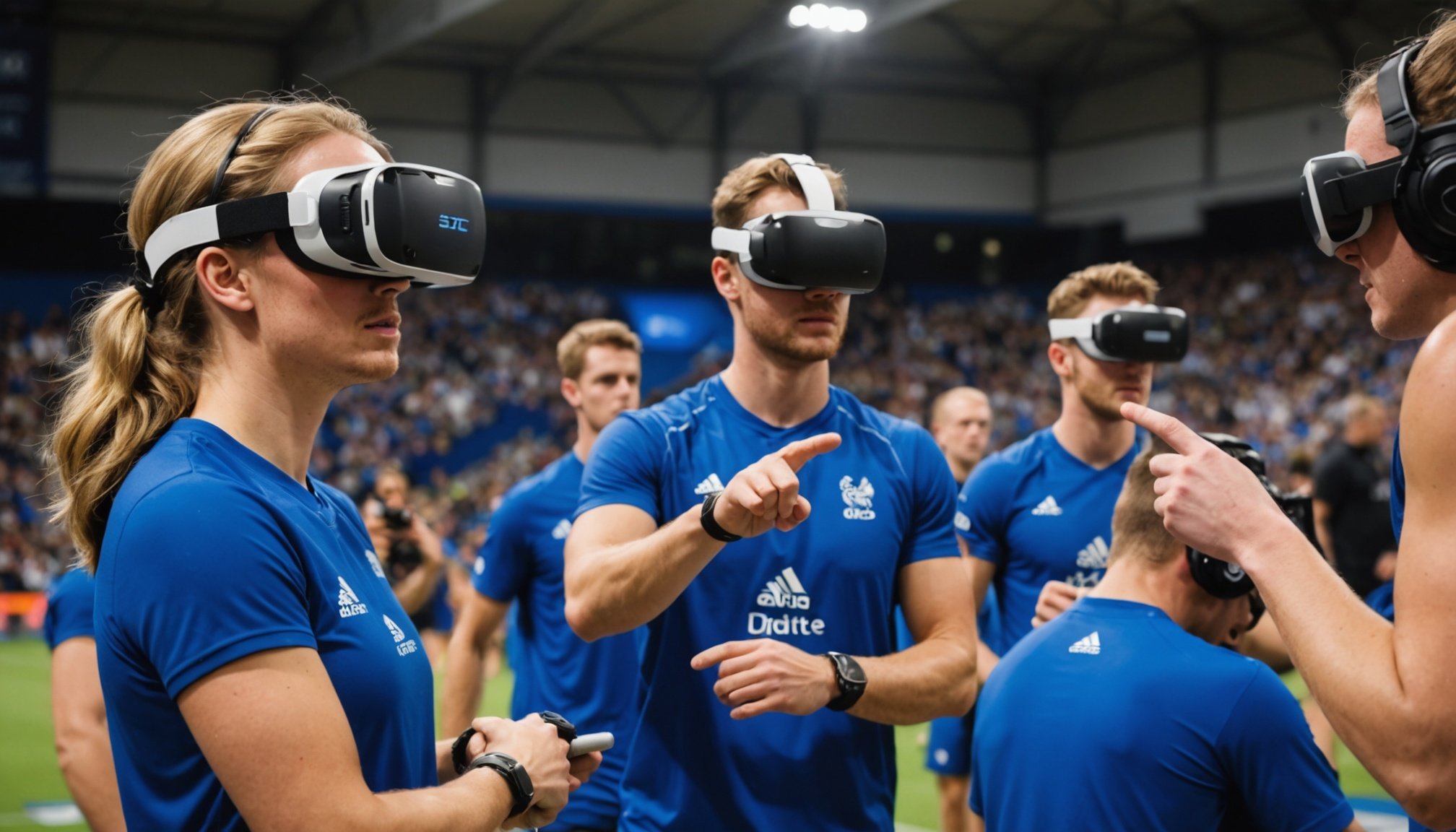Transforming Sports Training: How Virtual Reality is Shaping the Future of UK Athletic Teams
The Rise of Virtual Reality in Sports
Virtual reality (VR) is no longer just a buzzword in the tech world; it has firmly established itself as a game-changer in various industries, including sports. For UK athletic teams, VR is not just a novelty but a powerful tool that is revolutionizing the way athletes train, coaches strategize, and fans engage.
From Traditional to Virtual Training
Traditional sports training methods, while effective, have their limitations. Coaches can only observe so much, and athletes can only practice so many times before fatigue sets in. VR technology, however, offers a dynamic and highly realistic digital environment that can be tailored to specific training needs.
This might interest you : Elevating team unity: effective techniques for enhancing cohesion in uk rowing clubs
For instance, in table tennis, VR technology has been shown to enhance skill improvement significantly compared to traditional methods. A study published in MDPI’s Sensors journal highlighted that VR training improved serve accuracy by 23.5%, forehand consistency by 2.4, and backhand consistency by 2.2, all of which were statistically significant improvements over traditional training methods[2].
Enhancing Performance Analysis
Performance analysis is a critical component of sports training, and VR is taking this to the next level.
Also read : Essential stretching strategies for uk athletes to prevent injuries and boost performance
Real-Time Feedback and Adaptive Difficulty
VR systems can provide real-time visual and audio feedback, allowing athletes to adjust their techniques immediately. For example, in VR table tennis training, athletes can practice serves, returns, and drives with real-time feedback on their performance. The system can also adjust the difficulty level based on the athlete’s performance, ensuring that the training remains challenging yet manageable[2].
| Training Environment | VR Group | Traditional Group | Difference |
|
|----------|
|------------|
| Serve Accuracy (%) | +23.5 ± 4.2 | +15.8 ± 3.9 | +7.7 |
| Forehand Consistency (0–10) | +2.4 ± 0.8 | +2.1 ± 0.7 | +0.3 |
| Backhand Consistency (0–10) | +2.2 ± 0.9 | +1.9 ± 0.8 | +0.3 |
| Rally Endurance (shots) | +8.2 ± 2.3 | +5.7 ± 2.1 | +2.5 |
Data-Driven Insights
VR training sessions generate a wealth of data that can be analyzed to provide deep insights into athlete performance. Coaches can use this data to identify areas of improvement, track progress over time, and make informed decisions about training programs.
“VR technology offers an innovative approach to training e-athletes by immersing them in dynamic and highly realistic digital environments,” notes a study on amplifying cognitive functions in amateur esports athletes. This approach not only enhances reaction time and motor time but also improves eye-hand coordination, all critical components of athletic performance[3].
Injury Prevention and Rehabilitation
Injury prevention and rehabilitation are crucial aspects of sports training, and VR is proving to be a valuable tool in these areas.
Personalized Training Programs
VR can be used to create personalized training programs that cater to the specific needs of each athlete. For instance, BeONE Sports uses AI and computer vision to provide customized biomechanics coaching feedback. Athletes can record their movements and compare them with videos of leading athletes, receiving real-time feedback on their technique. This not only helps in improving performance but also in preventing injuries by identifying and correcting flawed techniques[1].
Real-Time Monitoring
Wearable sensors and computer vision technologies can monitor athletes’ physical condition in real-time, allowing coaches to intervene before an injury occurs. For example, in football, coaches can use wearable sensors to track players’ exhaustion levels and replace them before a mistake or injury happens[1].
Fan Engagement and the Viewing Experience
VR is not just about training; it’s also about enhancing the fan experience.
Immersive Viewing
Fans can now experience sports in a completely new way through VR. Imagine watching a football match from the perspective of a player on the field or feeling the intensity of a tennis match as if you were right there on the court. VR technology provides an immersive viewing experience that brings fans closer to the action than ever before.
“Virtual reality is changing the way we consume sports,” says Martin Foster, host of Loughborough University’s ‘Experts in Sport’ podcast. “It’s not just about watching a game; it’s about being part of it”[5].
The Future of Sports Technology
As VR continues to evolve, it’s clear that it will play a significant role in the future of sports technology.
Integration with Other Technologies
VR is often used in conjunction with other cutting-edge technologies like artificial intelligence (AI) and augmented reality (AR). For example, AI can analyze data from VR training sessions to provide detailed performance analysis, while AR can enhance the training environment by overlaying digital information onto the real world.
“AI technologies can collect additional unique data and do it precisely and in a personalized way, thereby enhancing the training process,” explains MobiDev, a company specializing in sports and fitness solutions based on computer vision and pose estimation models[1].
Digital Transformation in Sports
The integration of VR and other technologies is driving a digital transformation in sports. This transformation is not just about adopting new tools but about changing the way teams operate, from training and coaching to fan engagement and performance analysis.
“Digital transformation in sports is about leveraging technology to gain a competitive edge,” notes Dr. Mike Young, a renowned coach and sport scientist at Athletic Lab. “It’s about using data analytics and cutting-edge technologies to maximize performance and minimize injuries”[4].
Practical Insights and Actionable Advice
For UK athletic teams looking to integrate VR into their training programs, here are some practical insights and actionable advice:
- Start Small: Begin with simple VR training sessions and gradually increase the complexity as athletes become more comfortable with the technology.
- Invest in Quality Equipment: Ensure that the VR equipment is of high quality to provide a realistic and immersive experience.
- Use Data Analytics: Analyze the data generated from VR training sessions to gain insights into athlete performance and make informed decisions.
- Combine with Other Technologies: Integrate VR with AI, AR, and other technologies to enhance the training experience.
- Focus on Injury Prevention: Use VR to identify and correct flawed techniques that could lead to injuries.
Virtual reality is transforming the landscape of sports training in the UK and beyond. From enhancing performance analysis and injury prevention to improving fan engagement, VR is a powerful tool that is here to stay. As technology continues to evolve, it will be exciting to see how VR shapes the future of athletic teams and the sports industry as a whole.
In the words of Maciej Lachowicz, author of a study on amplifying cognitive functions in amateur esports athletes, “VR technology is not just a tool; it’s a game-changer. It’s about creating a new era in sports training where athletes can perform better, coaches can strategize more effectively, and fans can experience sports in a whole new way”[3].











